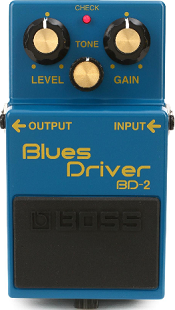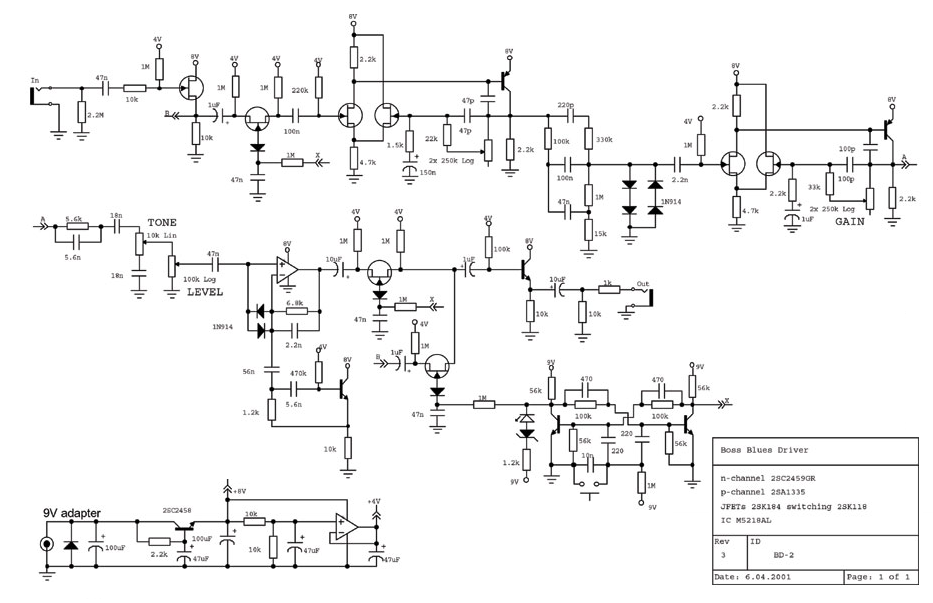Difference between revisions of "BD-2"
(→Phase Inversion: No) |
(→Phase Inversion: No) |
||
| Line 60: | Line 60: | ||
We may also end up changing out the IC that many consider cheap and substandard. We're thinking about replacing the stock M5218 for an OPA1642 for a better noise floor. However, it is also the case that the BD-2 is actually a pretty good sounding pedal in its own right and it may be the "cheapness" of the M5218 that provides the necessary character for the BD-2. We'll have to experiment and see. | We may also end up changing out the IC that many consider cheap and substandard. We're thinking about replacing the stock M5218 for an OPA1642 for a better noise floor. However, it is also the case that the BD-2 is actually a pretty good sounding pedal in its own right and it may be the "cheapness" of the M5218 that provides the necessary character for the BD-2. We'll have to experiment and see. | ||
| − | * There are additional transistors but these are '''"switch"''' or '''"buffer"''' electronics and have to do with the footswitch toggling the pedal on and off. That makes them irrelevant to the overdrive effect and tone. Of course, they could operate as a "tone suck" but this pedal hasn't been accused of such. | + | * There are additional transistors shown in the schematic, but these are '''"switch"''' or '''"buffer"''' electronics and have to do with the footswitch toggling the pedal on and off. That makes them irrelevant to the overdrive effect and tone. Of course, they could operate as a "tone suck" but this pedal hasn't been accused of such. |
Given the numerous amplification stages inside the BD-2 and given that the M5218 is but one of those stages, it's entirely possible that replacement would result in no discernable improvement. | Given the numerous amplification stages inside the BD-2 and given that the M5218 is but one of those stages, it's entirely possible that replacement would result in no discernable improvement. | ||
Revision as of 01:33, 1 November 2018
Boss BD-2 Blues Driver. While there is a complaint that some have regarding the pedal being treble-heavy, this is otherwise a well-respected overdrive pedal that can also veer into distortion tones when the highest levels of gain are dialed in.
Controls

- Knob 1: "Level": Pedal volume. Turn the knob fully counter-clockwise to turn down volume.
- Knob 2: "Tone": Fully clockwise is maximum treble frequencies in the tone. As knob is turned counter-clockwise those frequencies are filtered out.
- Knob 3: "Gain": Sets the level of overdrive/distortion of the pedal. Turning the knob clockwise increases the amount of overdrive/distortion.
- Footswitch 1: "On/Off": Toggles the pedal on or off.
While characterized as a good-sounding overdrive/distortion, the Blues Driver is also known for being "ice-picky" in the tone department, with a preponderance of treble frequencies. Most players end up having to turn down the tone knob in order to roll off those treble frequencies.
Bypass: Buffered
All Boss pedals are buffered. The BD-2 is not an exception.
General Information
Having been created and released in 1995, the BD-2 Blues Driver is an overdrive/distortion pedal that is a late-comer to the Boss line-up of largely well-respected overdrive pedals.
In the middle of 2017, Boss appears to have changed the PCB that hosts the BD-2 circuit. Inside the updated BD-2 is a far smaller PCB indicating that the manufacture of the Blues Driver has gone to fully-SMD based fabrication.
There are modifications of the BD-2 that can change the tonal character of the pedal. Most specifically, we have bought a Monte Allums modification (linked below) for the BD-2. We have purchased the modification and are applying it to our own BD-2 in order to tame the "ice-pickyness" and deliver a smoother sounding overdrive. If you are intending to modify your Blues Driver, you're going to have to make sure you have a pre-2017 pedal so that the electronics are can be modified.
Modifications
We have purchased and have applied the Boss BD-2 Pedal Mod Kit from Monte Allums[1] as we feel it helps fix the ice-pickiness of the pedal along with making it a "throatier" or "meatier" overdrive. It makes the BD-2 a pedal that we're more likely to use, helps create musical tones that help inspire us to play more. We figure it'll inspire other players to play more as well.
Pedal Manual
Phase Inversion: No
Our analysis suggests that this pedal does not invert phase.
| Schematic ID | Electronic Part | Action | Phase State |
|---|---|---|---|
| Q1 | 2SK184 | Does Not Invert | Not Inverted |
| Q2 | 2SK184 | Does Not Invert (switch) | Not Inverted |
| Q3 | 2SK184 | Inverts | Inverted |
| Q4 | 2SK184 | Inverts | Reverted |
| Q5 | 2SA1335 | Does Not Invert | Reverted |
| Q6 | 2SK184 | Inverts | Inverted |
| Q7 | 2SK184 | Inverts | Reverted |
| Q8 | 2SA1335 | Does Not Invert | Reverted |
| IC1a | M5218 | Does Not Invert | Reverted |
| Q9 | 2SC2459 | Does Not Invert | Reverted |
We may also end up changing out the IC that many consider cheap and substandard. We're thinking about replacing the stock M5218 for an OPA1642 for a better noise floor. However, it is also the case that the BD-2 is actually a pretty good sounding pedal in its own right and it may be the "cheapness" of the M5218 that provides the necessary character for the BD-2. We'll have to experiment and see.
- There are additional transistors shown in the schematic, but these are "switch" or "buffer" electronics and have to do with the footswitch toggling the pedal on and off. That makes them irrelevant to the overdrive effect and tone. Of course, they could operate as a "tone suck" but this pedal hasn't been accused of such.
Given the numerous amplification stages inside the BD-2 and given that the M5218 is but one of those stages, it's entirely possible that replacement would result in no discernable improvement.
Schematic
Artists
- Billie Joe Armstrong
- Randy Bachman
- Andy Timmons
- Additional Sources
